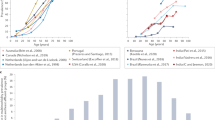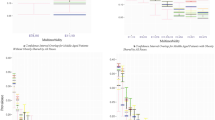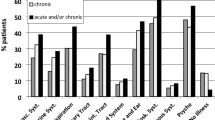Abstract
Globally, the number of people with multiple co-occurring diseases will increase substantially over the coming decades, with important consequences for patients, carers, healthcare systems and society. Addressing this challenge requires a shift in the prevailing clinical, educational and scientific thinking and organization—with a strong emphasis on the maintenance of generalist skills to balance the specialization trends of medical education and research. Multimorbidity is not a single entity but differs quantitively and qualitatively across life stages, ethnicities, sexes, socioeconomic groups and geographies. Data-driven science that quantifies the impact of disease co-occurrence—beyond the small number of currently well-studied long-term conditions (such as cardiometabolic diseases)—can help illuminate the pathological diversity of multimorbidity and identify common, mechanistically related, and prognostically relevant clusters. Broader access to data opportunities across modalities and disciplines will catalyze vertical and horizontal integration of multimorbidity research, to enable reconfiguring of medical services, clinical trials, guidelines and research in a way that accounts for the complexity of multimorbidity—and provides efficient, joined-up services for patients.
This is a preview of subscription content, access via your institution
Access options
Access Nature and 54 other Nature Portfolio journals
Get Nature+, our best-value online-access subscription
$29.99 / 30 days
cancel any time
Subscribe to this journal
Receive 12 print issues and online access
$209.00 per year
only $17.42 per issue
Buy this article
- Purchase on Springer Link
- Instant access to full article PDF
Prices may be subject to local taxes which are calculated during checkout



Similar content being viewed by others
References
Kingston, A. et al. Projections of multi-morbidity in the older population in England to 2035: estimates from the Population Ageing and Care Simulation (PACSim) model. Age Ageing 47, 374–380 (2018).
Whitty, C. J. M. et al. Rising to the challenge of multimorbidity. BMJ 368, l6964 (2020).
Whitty, C. J. M. & Watt, F. M. Map clusters of diseases to tackle multimorbidity. Nature 579, 494–496 (2020).
Kuan, V. et al. Identifying and visualising multimorbidity and comorbidity patterns in patients in the English National Health Service: a population-based study. Lancet Digit. Health 5, e16–e27 (2023).
Kivimaki, M. et al. Association between socioeconomic status and the development of mental and physical health conditions in adulthood: a multi-cohort study. Lancet Public Health 5, e140–e149 (2020).
Barnett, K. et al. Epidemiology of multimorbidity and implications for health care, research, and medical education: a cross-sectional study. Lancet 380, 37–43 (2012).
Academy of Medical Sciences. Multiple Long-Term Conditions (Multimorbidity): a priority for global health research (2018). Available at: https://acmedsci.ac.uk/file-download/82222577
van Leeuwen, F. E. & Ng, A. K. Long-term risk of second malignancy and cardiovascular disease after Hodgkin lymphoma treatment. Hematology Am. Soc. Hematol. Educ. Program 2016, 323–330 (2016).
Bjornevik, K. et al. Longitudinal analysis reveals high prevalence of Epstein–Barr virus associated with multiple sclerosis. Science 375, 296–301 (2022).
Ho, I. S. et al. Examining variation in the measurement of multimorbidity in research: a systematic review of 566 studies. Lancet Public Health 6, e587–e597 (2021).
Ho, I. S. S. et al. Measuring multimorbidity in research: Delphi consensus study. BMJ Med. 1, e000247 (2022).
Thygesen, J. H. et al. COVID-19 trajectories among 57 million adults in England: a cohort study using electronic health records. Lancet Digit. Health 4, e542–e557 (2022).
Raisi-Estabragh, Z. et al. Cardiovascular disease and mortality sequelae of COVID-19 in the UK Biobank. Heart 109, 119–126 (2022).
Wiersinga, W. J. et al. Melioidosis. Nat. Rev. Dis. Prim. 4, 17107 (2018).
Shaw J, M. N. Opportunistic infections in HIV. Medicine 50, 294–297 (2022).
Ho, I. S. et al. Variation in the estimated prevalence of multimorbidity: systematic review and meta-analysis of 193 international studies. BMJ Open 12, e057017 (2022).
Skou, S. T. et al. Multimorbidity. Nat. Rev. Dis. Prim. 8, 48 (2022).
Jensen, A. B. et al. Temporal disease trajectories condensed from population-wide registry data covering 6.2 million patients. Nat. Commun. 5, 4022 (2014).
Westergaard, D. et al. Uncovering the heritable components of multimorbidities and disease trajectories: a nationwide cohort study. Preprint at medRxiv https://doi.org/10.1101/2023.02.08.23285642 (2023).
van Rheenen, W., Peyrot, W. J., Schork, A. J., Lee, S. H. & Wray, N. R. Genetic correlations of polygenic disease traits: from theory to practice. Nat. Rev. Genet. 20, 567–581 (2019).
Pushpakom, S. et al. Drug repurposing: progress, challenges and recommendations. Nat. Rev. Drug Discov. 18, 41–58 (2019).
Cowie, M. R. & Fisher, M. SGLT2 inhibitors: mechanisms of cardiovascular benefit beyond glycaemic control. Nat. Rev. Cardiol. 17, 761–772 (2020).
Gram, H. The long and winding road in pharmaceutical development of canakinumab from rare genetic autoinflammatory syndromes to myocardial infarction and cancer. Pharmacol. Res. 154, 104139 (2020).
Hingorani, A. D. et al. Improving the odds of drug development success through human genomics: modelling study. Sci. Rep. 9, 18911 (2019).
Okada, Y. et al. Genetics of rheumatoid arthritis contributes to biology and drug discovery. Nature 506, 376–381 (2014).
Parisinos, C. A. et al. Variation in interleukin-6 receptor gene associates with risk of Crohn’s disease and ulcerative colitis. Gastroenterology 155, 303–306 (2018).
Harrison, S. C. et al. Interleukin-6 receptor pathways in abdominal aortic aneurysm. Eur. Heart J. 34, 3707–3716 (2013).
Interleukin-6 Receptor Mendelian Randomisation Analysis Consortium et al. The interleukin-6 receptor as a target for prevention of coronary heart disease: a mendelian randomisation analysis. Lancet 379, 1214–1224 (2012).
Ferreira, R. C. et al. Functional IL6R 358Ala allele impairs classical IL-6 receptor signaling and influences risk of diverse inflammatory diseases. PLoS Genet. 9, e1003444 (2013).
Nelson, M. R. et al. The support of human genetic evidence for approved drug indications. Nat. Genet. 47, 856–860 (2015).
King, E. A., Davis, J. W. & Degner, J. F. Are drug targets with genetic support twice as likely to be approved? Revised estimates of the impact of genetic support for drug mechanisms on the probability of drug approval. PLoS Genet. 15, e1008489 (2019).
Cook, D. et al. Lessons learned from the fate of AstraZeneca’s drug pipeline: a five-dimensional framework. Nat. Rev. Drug Discov. 13, 419–431 (2014).
Wheeler, J., McHale, M., Jackson, V. & Penny, M. Assessing theoretical risk and benefit suggested by genetic association studies of CCR5: experience in a drug development programme for maraviroc. Antivir. Ther. 12, 233–245 (2007).
Cohen, J. C., Boerwinkle, E., Mosley, T. H. Jr. & Hobbs, H. H. Sequence variations in PCSK9, low LDL, and protection against coronary heart disease. N. Engl. J. Med. 354, 1264–1272 (2006).
Bovijn, J., Lindgren, C. M. & Holmes, M. V. Genetic variants mimicking therapeutic inhibition of IL-6 receptor signaling and risk of COVID-19. Lancet Rheumatol. 2, e658–e659 (2020).
Suhre, K. et al. Connecting genetic risk to disease end points through the human blood plasma proteome. Nat. Commun. 8, 14357 (2017).
Pietzner, M. et al. Mapping the proteo-genomic convergence of human diseases. Science 374, eabj1541 (2021).
Koprulu, M. et al. Proteogenomic links to human metabolic diseases. Nat. Metab. 5, 516–528 (2023).
Barrio-Hernandez, I. et al. Network expansion of genetic associations defines a pleiotropy map of human cell biology. Nat. Genet. 55, 389–398 (2023).
Giambartolomei, C. et al. Bayesian test for colocalisation between pairs of genetic association studies using summary statistics. PLoS Genet. 10, e1004383 (2014).
Foley, C. N. et al. A fast and efficient colocalization algorithm for identifying shared genetic risk factors across multiple traits. Nat. Commun. 12, 764 (2021).
Zuber, V. et al. Multi-response Mendelian randomization: identification of shared and distinct exposures for multimorbidity and multiple related disease outcomes. Preprint at bioRxiv https://doi.org/10.1101/2023.02.01.526689 (2023).
Pietzner, M. et al. Genetic architecture and shared mechanisms of common ‘neglected’ diseases. Preprint at MedRxiv https://doi.org/10.1101/2023.05.23.23290408 (2023).
Zheng, J. et al. Phenome-wide Mendelian randomization mapping the influence of the plasma proteome on complex diseases. Nat. Genet. 52, 1122–1131 (2020).
Folkersen, L. et al. Genomic and drug target evaluation of 90 cardiovascular proteins in 30,931 individuals. Nat. Metab. 2, 1135–1148 (2020).
Barbeira, A. N. et al. Exploiting the GTEx resources to decipher the mechanisms at GWAS loci. Genome Biol. 22, 49 (2021).
Ferkingstad, E. et al. Large-scale integration of the plasma proteome with genetics and disease. Nat. Genet. 53, 1712–1721 (2021).
Lotta, L. A. et al. A cross-platform approach identifies genetic regulators of human metabolism and health. Nat. Genet. 53, 54–64 (2021).
Pietzner, M. et al. ELF5 is a potential respiratory epithelial cell-specific risk gene for severe COVID-19. Nat. Commun. 13, 4484 (2022).
Surendran, P. et al. Rare and common genetic determinants of metabolic individuality and their effects on human health. Nat. Med. 28, 2321–2332 (2022).
Holmes, M. V. et al. Association between alcohol and cardiovascular disease: Mendelian randomisation analysis based on individual participant data. BMJ 349, g4164 (2014).
Biddinger, K. J. et al. Association of habitual alcohol intake with risk of cardiovascular disease. JAMA Netw. Open 5, e223849 (2022).
Dale, C. E. et al. Causal associations of adiposity and body fat distribution with coronary heart disease, stroke subtypes and type 2 diabetes mellitus: a Mendelian randomization analysis. Circulation 135, 2373–2388 (2017).
Venkatesh, S. S. et al. Obesity and risk of female reproductive conditions: a Mendelian randomisation study. PLoS Med. 19, e1003679 (2022).
Huang, J. et al. Genomics and phenomics of body mass index reveals a complex disease network. Nat. Commun. 13, 7973 (2022).
Pietzner, M. et al. Plasma metabolites to profile pathways in noncommunicable disease multimorbidity. Nat. Med. 27, 471–479 (2021).
Proietti, M. et al. Association between clinical risk scores and mortality in atrial fibrillation: systematic review and network meta-regression of 669,000 patients. Eur. J. Prev. Cardiol. 27, 633–644 (2020).
Tomic, D., Shaw, J. E. & Magliano, D. J. The burden and risks of emerging complications of diabetes mellitus. Nat. Rev. Endocrinol. 18, 525–539 (2022).
Farmer, C., Fenu, E., O’Flynn, N. & Guthrie, B. Clinical assessment and management of multimorbidity: summary of NICE guidance. BMJ 354, i4843 (2016).
Aronson, J. K. Polypharmacy, appropriate and inappropriate. Br. J. Gen. Pract. 56, 484–485 (2006).
Aronson, J. K. In defence of polypharmacy. Br. J. Clin. Pharm. 57, 119–120 (2004).
Pirmohamed, M. et al. Adverse drug reactions as cause of admission to hospital: prospective analysis of 18 820 patients. BMJ 329, 15–19 (2004).
Dale, C. E. et al. The impact of the COVID-19 pandemic on cardiovascular disease prevention and management. Nat. Med. 29, 219–225 (2023).
Acknowledgements
We thank J. Carrasco-Zanini, M. Pietzner and H. Hemingway for assistance with references, figures and comments on an earlier draft of this Review. C.L. and A.D.H. are supported by the UK Research and Innovation (UKRI) Strategic Priority Fund Tackling multimorbidity at scale programme (grant number MR/V033867/1) delivered by the Medical Research Council and the National Institute for Health and Care Research (NIHR) in partnership with the Economic and Social Research Council and in collaboration with the Engineering and Physical Sciences Research Council. A.D.H. is funded by the NIHR University College London Hospitals NHS Trust Biomedical Research Centre.
Author information
Authors and Affiliations
Corresponding author
Ethics declarations
Competing interests
The authors declare no competing interests.
Peer review
Peer review information
Nature Medicine thanks Ioanna Tzoulaki, Heinz Freisling and the other, anonymous reviewer(s) for their contribution to the peer review of this work. Primary handling editor: Karen O’Leary, in collaboration with the Nature Medicine team.
Additional information
Publisher’s note Springer Nature remains neutral with regard to jurisdictional claims in published maps and institutional affiliations.
Rights and permissions
Springer Nature or its licensor (e.g. a society or other partner) holds exclusive rights to this article under a publishing agreement with the author(s) or other rightsholder(s); author self-archiving of the accepted manuscript version of this article is solely governed by the terms of such publishing agreement and applicable law.
About this article
Cite this article
Langenberg, C., Hingorani, A.D. & Whitty, C.J.M. Biological and functional multimorbidity—from mechanisms to management. Nat Med 29, 1649–1657 (2023). https://doi.org/10.1038/s41591-023-02420-6
Received:
Accepted:
Published:
Issue Date:
DOI: https://doi.org/10.1038/s41591-023-02420-6
This article is cited by
-
Development and validation of prognostic machine learning models for short- and long-term mortality among acutely admitted patients based on blood tests
Scientific Reports (2024)
-
Improving generalization of machine learning-identified biomarkers using causal modelling with examples from immune receptor diagnostics
Nature Machine Intelligence (2024)
-
Genomic insights into the comorbidity between type 2 diabetes and schizophrenia
Schizophrenia (2024)
-
Rising to the challenge of defining and operationalising multimorbidity in a UK hospital setting: the ADMISSION research collaborative
European Geriatric Medicine (2024)
-
Building healthy populations
Nature Medicine (2023)



